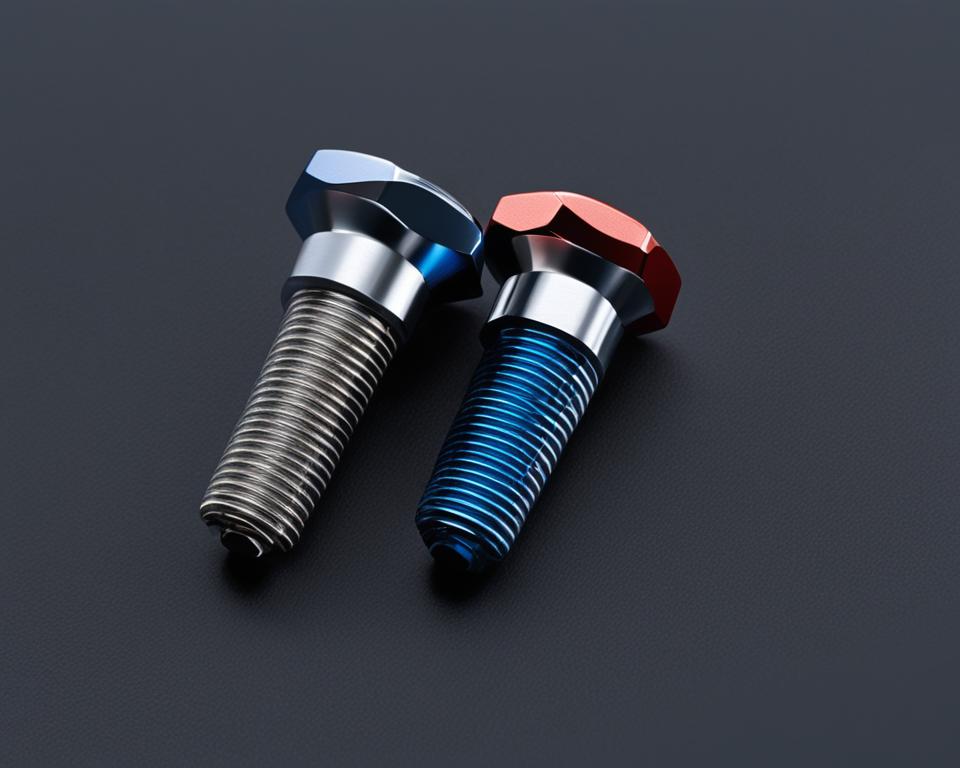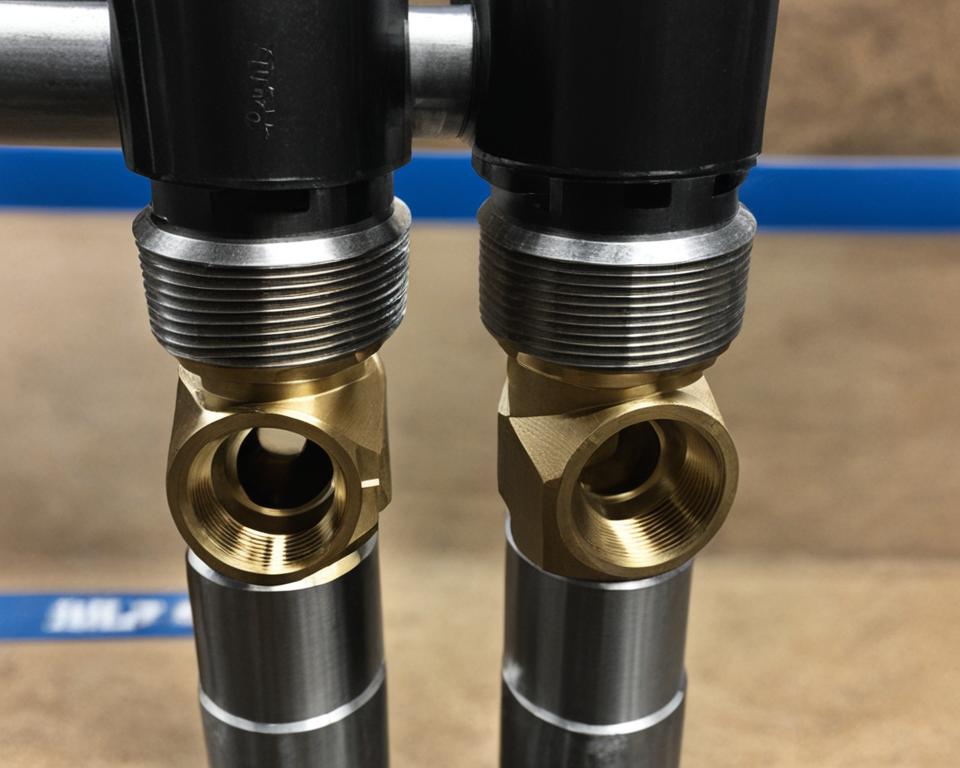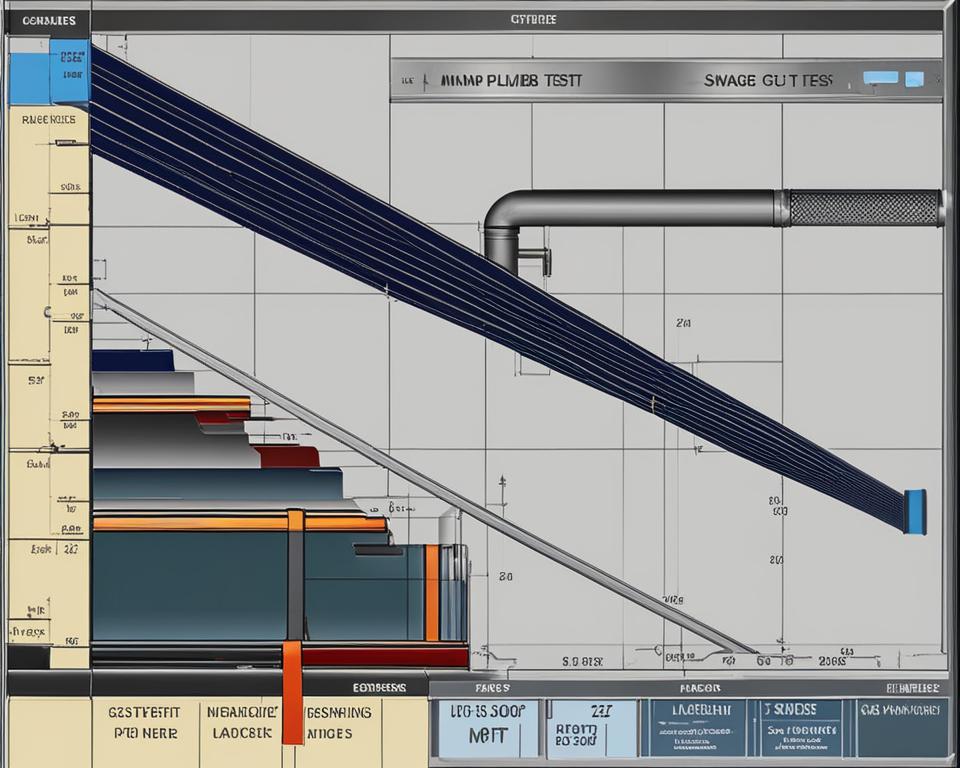When it comes to pipe and fitting installations, understanding thread standards is crucial. Two commonly used thread types are NPT (National Pipe Threads) and IPT (Iron Pipe Threads). While these terms may seem confusing, we’re here to help you decode the differences.
NPT, also known as IPT, is a tapered thread standard. As you tighten NPT or IPT fittings, the threads wedge together tightly, ensuring a secure and leak-free connection. On the other hand, compression fittings and flare fittings use parallel threads without a taper. Understanding the distinctions between these thread types is vital for selecting the appropriate fittings for your specific needs.
Key Takeaways:
- IPT and NPT are terms used interchangeably and refer to threaded pipe fittings.
- NPT or IPT threads are tapered and require tightening to create a leak-free joint.
- Compression fittings and flare fittings utilize parallel threads without a taper.
- Choose the correct thread type based on your specific application.
- Tapered threads like NPT and IPT are not compatible with other thread standards, such as BSPT (British Standard Pipe Threads).
Understanding Thread Types: NPT and IPT
NPT (National Pipe Tapered) and IPT (Iron Pipe Thread) are the two most commonly used thread standards for pipes and fittings. NPT threads are tapered, meaning that as you tighten NPT fittings, the threads wedge together more tightly, creating a leak-free joint. IPT threads, which are equivalent to NPT threads, can be used interchangeably. Both NPT and IPT are suitable for use with pipe connections.
When it comes to thread standards, it’s important to consider the specific requirements of your project. NPT threads are widely used and offer a reliable and secure connection. The taper design helps to prevent leaks, making NPT threads a popular choice for applications where a tight seal is essential.
“NPT threads provide a secure and leak-free joint, making them ideal for a wide range of pipe connections.”
In contrast, IPT threads share the same taper design as NPT threads and are often used interchangeably. This means that you can use NPT fittings with IPT threads and vice versa without any issues. The compatibility and versatility of NPT and IPT threads make them convenient options for various piping applications.
Understanding the differences between NPT and IPT threads is crucial for selecting the appropriate thread type for your specific project. Whether you choose NPT or IPT, both thread standards offer reliable connections that can withstand the demands of pipe installations.
Next, we will explore the characteristics of NPT threads in more detail, including the thread angle, dimensions, and the importance of using thread sealant to ensure a secure connection.
Characteristics of NPT Threads
NPT (National Pipe Tapered) threads are widely used in pipe and fitting installations due to their specific characteristics. Understanding the characteristics of NPT threads is crucial for ensuring a secure and leak-free connection.
Taper Angle
NPT threads have a characteristic taper angle of about 1° 47′. This means that the diameter of the threads gradually decreases towards the end of the fitting, allowing for a tight and secure fit.
Thread Angle
The threads of NPT fittings are cut at an angle of approximately 60° along the length of the fitting. This creates a wedging effect when the male and female threads are tightened, resulting in a tight seal.
Thread Dimensions
The dimensions of NPT threads are standardized to ensure compatibility and interchangeability. The thread dimensions specify the size and pitch of the threads, enabling proper fitting and connection in pipe systems.
Thread Sealant
Due to variations in thread cuts, it is essential to use a pipe thread sealant with NPT threads to ensure a leak-free connection. Commonly used sealants include Teflon tape and pipe thread sealant. By applying a thread sealant, the gaps between the threads are filled, providing an additional layer of protection against leaks.
In NPT fittings, the male threads are referred to as MPT (Male Pipe Thread), while the female threads are referred to as FPT (Female Pipe Thread). These designations help identify the appropriate fitting for a particular connection.

Now that we have explored the characteristics of NPT threads, let’s move on to understanding the thread characteristics of IPT threads in the next section.
Characteristics of IPT Threads
IPT (Iron Pipe Thread) is equivalent to NPT and is also sometimes referred to as IPS (Iron Pipe Straight). IPT threads have the same taper angle as NPT threads and are cut at an angle of about 60° along the length of the fitting. Male IPT fittings are designated as MPT and female IPT fittings are designated as FPT.
| Characteristic | Value |
|---|---|
| Taper Angle | Same as NPT threads |
| Cut Angle | 60° |
| Male Fittings | MPT (Male Iron Pipe Thread) |
| Female Fittings | FPT (Female Iron Pipe Thread) |
Like NPT threads, IPT threads are commonly used in pipe and fitting installations. Their compatibility with NPT threads allows for seamless interchangeability, providing flexibility in choosing the appropriate thread type for specific applications.
Understanding the characteristics of IPT threads, including the taper angle, cut angle, and designated fittings, is crucial for ensuring proper installation and compatibility in plumbing systems.
Compatibility of NPT and IPT Threads
When it comes to compatibility, NPT (National Pipe Tapered) and IPT (Iron Pipe Thread) threads have you covered. These thread standards are interchangeable, allowing you to use NPT fittings with IPT threads and vice versa without any compatibility issues. This versatility makes it easier to connect pipes and fittings, providing flexibility in your plumbing projects.
However, it’s crucial to remember that NPT and IPT threads are not compatible with other thread types such as BSPT (British Standard Pipe Threads). Therefore, it’s essential to use the correct thread type for your specific application to ensure a proper fit and avoid potential leakage or other issues.
To summarize:
NPT and IPT threads can be used interchangeably, allowing you to use NPT fittings with IPT threads and vice versa.
However, NPT and IPT threads are not compatible with other thread types such as BSPT.
To help further illustrate the compatibility between NPT and IPT threads, here’s a table detailing the connection types and fittings:
| NPT Connections | IPT Connections |
|---|---|
| NPT fittings | IPT threads |
| IPT fittings | NPT threads |

The table above provides a clear visual representation of how NPT fittings can be connected to IPT threads and vice versa. This compatibility makes it easier to find the right fittings for your plumbing needs, ensuring a secure and reliable connection.
Now that we understand the compatibility of NPT and IPT threads, let’s explore other thread standards and their unique characteristics in the next section.
Other Thread Standards
In addition to NPT and IPT, there are other thread standards used in various applications. These include BSPT (British Standard Pipe Threads), UNC (Unified National Coarse), UNF (Unified National Fine), and Whitworth threads.
BSPT (British Standard Pipe Threads)
BSPT threads are similar to NPT threads but have a different flank angle of 55°. They are commonly used in British standard pipe fittings and provide a secure and reliable connection.
UNC (Unified National Coarse) and UNF (Unified National Fine) Threads
UNC and UNF threads are widely used in the United States and offer different thread pitches. UNC threads have a coarser pitch and are ideal for applications that require higher strength, while UNF threads have a finer pitch and are suitable for applications that require finer adjustments or a more precise fit.
Whitworth Threads
Whitworth threads, designated as G for parallel threads and R for tapered threads, are commonly used in British standard pipe fittings. They provide a reliable and leak-free connection.
| Thread Standard | Flank Angle | Common Applications |
|---|---|---|
| BSPT (British Standard Pipe Threads) | 55° | British standard pipe fittings |
| UNC (Unified National Coarse) | 60° | General applications requiring higher strength |
| UNF (Unified National Fine) | 60° | Applications requiring finer adjustments or a more precise fit |
| Whitworth Threads | Parallel (G) / Tapered (R) | British standard pipe fittings |

Conclusion
In conclusion, understanding the differences between NPT and IPT thread standards is crucial for ensuring compatibility and seal integrity in pipe and fitting installations. Both NPT (National Pipe Tapered) and IPT (Iron Pipe Thread) are commonly used in plumbing applications. NPT threads are tapered and require the use of a sealant, such as Teflon tape or pipe thread sealant, to create a leak-free joint. On the other hand, IPT threads are essentially the same as NPT threads and can be used interchangeably.
When selecting the appropriate thread type for your application, it is important to consider factors such as the type of pipe and fitting, as well as the required pressure rating. Proper sealing is essential to prevent leaks and ensure the integrity of the installation. Both NPT and IPT threads can provide reliable and secure connections when installed correctly.
While NPT and IPT threads are compatible with each other, it is important to note that they are not compatible with other thread standards, such as BSPT (British Standard Pipe Threads). Therefore, it is crucial to use the correct thread type for your specific application to ensure optimal performance and avoid any potential issues.
In summary, understanding the characteristics and compatibility of NPT and IPT threads is essential in the world of plumbing. By selecting the appropriate thread type and ensuring proper sealing, you can achieve leak-free connections and create a reliable plumbing system that meets the required standards for your specific application.
FAQ
What is the difference between IPT and NPT?
The main difference between IPT (Iron Pipe Thread) and NPT (National Pipe Tapered) is in their names, with IPT being an alternative name for NPT. Both IPT and NPT are tapered pipe thread standards used for pipes and fittings.
Are NPT and IPT threads compatible with each other?
Yes, NPT and IPT threads are interchangeable and compatible with each other. This means you can use NPT fittings with IPT threads and vice versa without any issues. However, it is essential to use the correct thread type for your specific application, as NPT and IPT threads are not compatible with other thread standards.
Do NPT and IPT threads require a sealant for a leak-free joint?
Yes, NPT threads require the use of a pipe thread sealant, such as Teflon tape or pipe thread sealant, to ensure a leak-free joint. The taper of NPT threads allows the threads to wedge together tightly as you tighten the fittings, creating a secure seal.
What are the characteristics of NPT threads?
NPT threads have a taper angle of about 1° 47′ and are cut at an angle of about 60° along the length of the fitting. They require the use of a sealant due to variations in thread cuts and are available in both male (MPT) and female (FPT) options.
What are the characteristics of IPT threads?
IPT threads have the same taper angle and cutting angle as NPT threads. They are often used interchangeably with NPT threads and are available in both male (MPT) and female (FPT) options.
What other thread standards are there besides NPT and IPT?
Other thread standards include BSPT (British Standard Pipe Threads), UNC (Unified National Coarse), UNF (Unified National Fine), and Whitworth threads. These thread standards have different dimensions, angles, and applications.
What is the conclusion about thread standards?
Understanding thread standards, such as NPT and IPT, is crucial for ensuring compatibility and seal integrity in pipe and fitting installations. NPT and IPT threads are tapered and require the use of a sealant for a leak-free joint. It is important to select the appropriate thread type for your application and use the correct sealing method.
